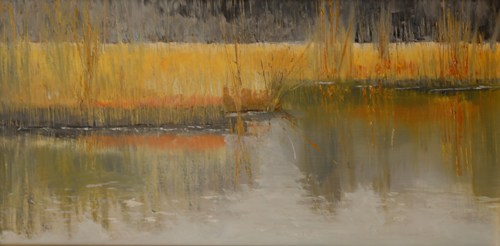An interview with Chesapeake painter David Terrar
I love your “golden hour” gallery. Can you explain the significance of the term?
A few years back I had a heart attack and was treated in a large teaching hospital. After the operation, all of the cardiology students came into the ICU and reviewed the charts. Each student mentioned the medical attention was given in the “golden hour,” a term unknown to me. About the fifth time a young cardiologist mentioned golden hour, I ask what is the golden hour. He mentioned it is the first hour a patient arrives in the hospital, but then he said “Sir in your case it was the last hour of life.” In the six weeks of mandatory rest, the words of the golden hour frequently raced through my mind. On one bright sunny fall afternoon I noticed the sun setting and the fantastic color shifting to many golden tones coming through the trees. The idea continued to grow in my mind “golden hour” the last hour of life and the last hour of the day. Then the challenge was born, how to illustrate the concept of the golden hour. In the 1990s I learned the gold leaf technique while studying icons in the local Russian Orthodox church, even though I am neither Russian nor Orthodox. After a lot of deep thought I started experimenting using gold leaf in the painting. I was encouraged after reviewing the work of Gustav Klimt and noticed how he used gold leaf and oil on canvas.
Gold has been a symbol of hope in painting for the last thousand years. It is also a symbol of light and warmth. Trees are a sign the strength, stability and beauty. The leaves are a symbol for their curative herbal and medicinal properties. So when I do a golden hour painting I am not just painting a bunch of trees with sunlight coming through them. I am saying “No matter what difficult problem a person is going through and suffering, there is a way to find strength and hope.” My wish is that people who are suffering, look at the paintings and are transported to a different place of healing that distracts them from the worry and anxiety of their suffering.
You’ve traveled a lot for school and for work. How has exploring the world affected your art? What are some of your favorite places to have visited or lived?
In every country and culture there are certain people who have had an “Oh Ha!” moment when they experienced rare beauty and have realized like the cavemen in Lascuax, France the they had to tell the story in a visual art fashion. In each country where I lived or worked I tried to learn about their artistic traditions. I spent several years in Africa and learned about the traditional masks which had a profound influence on the cubist movement. In France I learned about the impressionist especially Claude Monet. In Japan I studied the Sumi technique of painting grass and reeds. Each place added to my artistic databank and knowledge.
If I had the chance I would move to Paris, Hong Kong, or Istanbul. All are great centers of art. My real favorite place is the National Gallery of Art in Washington DC. If I have a difficult passage in a painting that’s got me stumped and just doesn’t look right, I visit the National Gallery and consult with Mr. Cezanne, or Mr. Monet or Mr. Klimt to see how they handled the same problem. They always have the answer, plus its free.
Despite your travels, much of your work is focused on the Chesapeake Bay region—your current home. Can you tell us what the area means to you?
I consider myself to be a regional artist, somewhat in the manner of Thomas Hart Benton. My region is the Chesapeake Bay. Looking at the Bay I find refreshing peace, calm and solitude. I find different colors combinations every day depending on the light and season and always something new to paint.
What literature, films, or music influence your painting?
I was greatly influenced by Mark Twain’s Adventures of Huck Finn and James Mitchner’s book Chesapeake. Both books deal with life on the water.
I have a constant ringing in my ear and music helps chase away the ringing. Jazz is my favorite, Cyrus Chestnut, Duke Ellington, Winton Marsallis, Miles Davis. I like their ability to explore different ways to present new ideas in music. It’s amazing to me to see all of the different genres of music and yet there are only 12 notes. I always have music when I paint.
5. Many of your paintings deal with marshes, bays, and ports. Can you explain the importance of water in your work?
My Bay paintings are an allegory. Water represents life, sometimes calm and peaceful sometimes dangerous and violent. Like Huck Finn, we are all drifting down the river of life for one adventure to another. Water is certainly the essence of life. The Bay provides beauty, commerce and trade with sea going ships, recreation and best of all crabs. The ports always have work boats. Some of the work boats are barely seaworthy yet day after day the watermen take them into the Bay for crabs, oysters and rockfish. They have a hard life in the daily struggle with the elements just to put food on the table. I am trying to portray their struggle as our struggle. As water represents the struggle of life, I believe we all have a boat or mechanism to carry us through the hard and difficult points in the river of life, like Huck Finn and his raft taking him down the Mississippi.
Sign up for our email list
Find out about new art and collections added monthly








